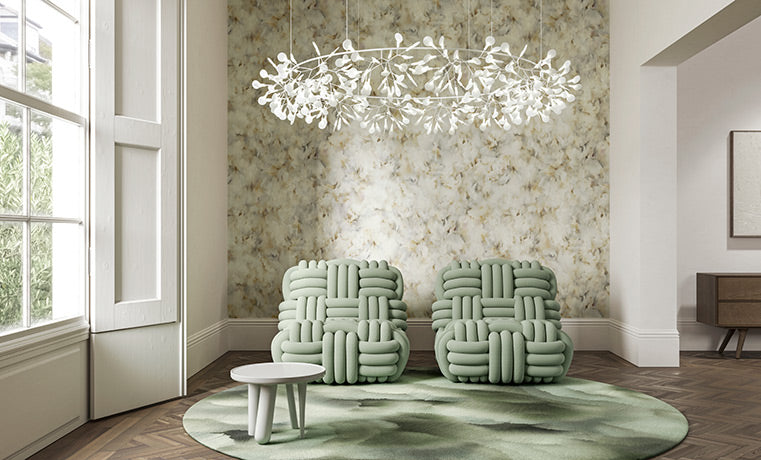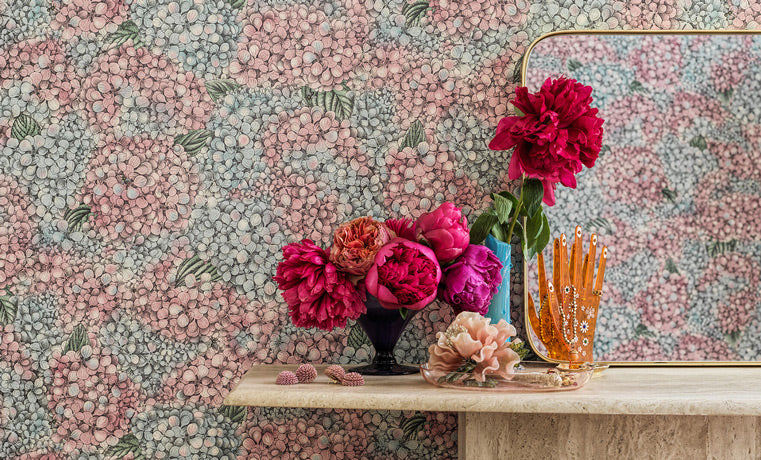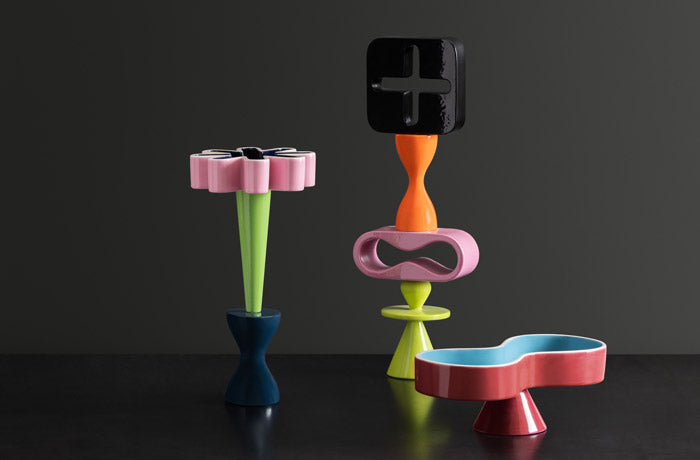
(Seaweed – 1954) Founded in 1860 by Arthur Sanderson and today known simply as ‘Sanderson’, the company has been a wholesale manufacturer for most of its existence, selling to the interiors market worldwide. To serve their needs the firm – which initially provided only wall coverings – introduced paints and associated supplies in 1900, illustrated style guides in 1911, and printed fabrics at the end of the First World War, when there severe paper shortages. Sanderson manufactured woven fabrics from 1934, but all production was curtailed by the Second World War, and war work occupied the factories from 1942-6. After the war stock and new designs took some time to replenish, and new pattern books were not issued until 1950. However, soon thereafter forward-looking modern styles were introduced, becoming key to Sanderson’s over the next two decades. By the early 1950′s, exhibitions orchestrated by government and trade agencies were educating and influencing consumer tastes. Sanderson, with its well-established reputation for customer service, adopted the same vehicle to showcase new collections, mounting exhibitions in 1952, 1954 and 1956. On each occasion the company’s extensive showroom in Berners Street, London, was transformed by specially constructed room sets and display devices. These had great impact. The Three Arts’, 1954, attracted 16,000 visitors over it’s ten-day run; equally successful was ‘Decorama’, 1956, with decorative schemes by Sir Hugh Casson, professor of interior design at the Royal College of Art from 1955-75

(Sanderson – 1960) Casson incorporated work by his students and associates, including Humphrey Spender, an RCA tutor from 1953-75. Together with products made by Sanderson at their own factories, the displays featured wallpapers and fabrics from Swedish, German and other manufacturers from outside the United Kingdom, for whom Sanderson acted as sole agents. Maintaining studios at Perivale (their wallpaper factory), Uxbridge (textiles) and Berners Street, Sanderson commissioned additional patterns from many artists, designers and studios, at hame and abroad. Thousands of designs were available by 1960 when the company celebrated it’s centenary with it’s opening of a distinctively modern Berners Street showroom, a London landmark designed by the architects Slater and Uren.

(Bali – 1963) Sanderson led in exports of British wallpapers and textiles at this time, balancing ‘bread-and-butter’ manufacturing with diverse, more expensive, products. Their wallpapers, in particular, catered to a wide range of clientele, employing several manufacturing techniques. Hand block- and screen- printing was used for limited edition reproductions and avant-garde designs, respectively. Their presses, the most advanced in the country, provided flock, surface, flexographic and gravure papers. The latter method, perfected by Harold Sanderson in 1923, produced disparate products, including faux wood and stone effects, printed papers for laminates, and vinyl wall coverings. Design choices were made by a committee incorporating Ivan Sanderson (Harold’s son and chairman from 1934-65), the sales and marketing teams, and the studio heads. This only changed in the Uxbridge fabric division when George Lowe was appointed in 1962. Lowe came to Sanderson from Lightbown Aspinall, part of the Wallpaper Manufacturers Ltd (WPM), a large consortium of wallpaper manufacturers founded in 1899, of which Sanderson was also a branch . Lowe drove forward the ‘Triad’ collections, launched from Perivale in 1962. These revolutionised mainstream interiors by providing a decorator look: an exactly matching paper and fabric, plus a companioned paper. To be continued…
 (Seaweed – 1954) Founded in 1860 by Arthur Sanderson and today known simply as ‘Sanderson’, the company has been a wholesale manufacturer for most of its existence, selling to the interiors market worldwide. To serve their needs the firm – which initially provided only wall coverings – introduced paints and associated supplies in 1900, illustrated style guides in 1911, and printed fabrics at the end of the First World War, when there severe paper shortages. Sanderson manufactured woven fabrics from 1934, but all production was curtailed by the Second World War, and war work occupied the factories from 1942-6. After the war stock and new designs took some time to replenish, and new pattern books were not issued until 1950. However, soon thereafter forward-looking modern styles were introduced, becoming key to Sanderson’s over the next two decades. By the early 1950′s, exhibitions orchestrated by government and trade agencies were educating and influencing consumer tastes. Sanderson, with its well-established reputation for customer service, adopted the same vehicle to showcase new collections, mounting exhibitions in 1952, 1954 and 1956. On each occasion the company’s extensive showroom in Berners Street, London, was transformed by specially constructed room sets and display devices. These had great impact. The Three Arts’, 1954, attracted 16,000 visitors over it’s ten-day run; equally successful was ‘Decorama’, 1956, with decorative schemes by Sir Hugh Casson, professor of interior design at the Royal College of Art from 1955-75
(Seaweed – 1954) Founded in 1860 by Arthur Sanderson and today known simply as ‘Sanderson’, the company has been a wholesale manufacturer for most of its existence, selling to the interiors market worldwide. To serve their needs the firm – which initially provided only wall coverings – introduced paints and associated supplies in 1900, illustrated style guides in 1911, and printed fabrics at the end of the First World War, when there severe paper shortages. Sanderson manufactured woven fabrics from 1934, but all production was curtailed by the Second World War, and war work occupied the factories from 1942-6. After the war stock and new designs took some time to replenish, and new pattern books were not issued until 1950. However, soon thereafter forward-looking modern styles were introduced, becoming key to Sanderson’s over the next two decades. By the early 1950′s, exhibitions orchestrated by government and trade agencies were educating and influencing consumer tastes. Sanderson, with its well-established reputation for customer service, adopted the same vehicle to showcase new collections, mounting exhibitions in 1952, 1954 and 1956. On each occasion the company’s extensive showroom in Berners Street, London, was transformed by specially constructed room sets and display devices. These had great impact. The Three Arts’, 1954, attracted 16,000 visitors over it’s ten-day run; equally successful was ‘Decorama’, 1956, with decorative schemes by Sir Hugh Casson, professor of interior design at the Royal College of Art from 1955-75  (Sanderson – 1960) Casson incorporated work by his students and associates, including Humphrey Spender, an RCA tutor from 1953-75. Together with products made by Sanderson at their own factories, the displays featured wallpapers and fabrics from Swedish, German and other manufacturers from outside the United Kingdom, for whom Sanderson acted as sole agents. Maintaining studios at Perivale (their wallpaper factory), Uxbridge (textiles) and Berners Street, Sanderson commissioned additional patterns from many artists, designers and studios, at hame and abroad. Thousands of designs were available by 1960 when the company celebrated it’s centenary with it’s opening of a distinctively modern Berners Street showroom, a London landmark designed by the architects Slater and Uren.
(Sanderson – 1960) Casson incorporated work by his students and associates, including Humphrey Spender, an RCA tutor from 1953-75. Together with products made by Sanderson at their own factories, the displays featured wallpapers and fabrics from Swedish, German and other manufacturers from outside the United Kingdom, for whom Sanderson acted as sole agents. Maintaining studios at Perivale (their wallpaper factory), Uxbridge (textiles) and Berners Street, Sanderson commissioned additional patterns from many artists, designers and studios, at hame and abroad. Thousands of designs were available by 1960 when the company celebrated it’s centenary with it’s opening of a distinctively modern Berners Street showroom, a London landmark designed by the architects Slater and Uren.  (Bali – 1963) Sanderson led in exports of British wallpapers and textiles at this time, balancing ‘bread-and-butter’ manufacturing with diverse, more expensive, products. Their wallpapers, in particular, catered to a wide range of clientele, employing several manufacturing techniques. Hand block- and screen- printing was used for limited edition reproductions and avant-garde designs, respectively. Their presses, the most advanced in the country, provided flock, surface, flexographic and gravure papers. The latter method, perfected by Harold Sanderson in 1923, produced disparate products, including faux wood and stone effects, printed papers for laminates, and vinyl wall coverings. Design choices were made by a committee incorporating Ivan Sanderson (Harold’s son and chairman from 1934-65), the sales and marketing teams, and the studio heads. This only changed in the Uxbridge fabric division when George Lowe was appointed in 1962. Lowe came to Sanderson from Lightbown Aspinall, part of the Wallpaper Manufacturers Ltd (WPM), a large consortium of wallpaper manufacturers founded in 1899, of which Sanderson was also a branch . Lowe drove forward the ‘Triad’ collections, launched from Perivale in 1962. These revolutionised mainstream interiors by providing a decorator look: an exactly matching paper and fabric, plus a companioned paper. To be continued…
(Bali – 1963) Sanderson led in exports of British wallpapers and textiles at this time, balancing ‘bread-and-butter’ manufacturing with diverse, more expensive, products. Their wallpapers, in particular, catered to a wide range of clientele, employing several manufacturing techniques. Hand block- and screen- printing was used for limited edition reproductions and avant-garde designs, respectively. Their presses, the most advanced in the country, provided flock, surface, flexographic and gravure papers. The latter method, perfected by Harold Sanderson in 1923, produced disparate products, including faux wood and stone effects, printed papers for laminates, and vinyl wall coverings. Design choices were made by a committee incorporating Ivan Sanderson (Harold’s son and chairman from 1934-65), the sales and marketing teams, and the studio heads. This only changed in the Uxbridge fabric division when George Lowe was appointed in 1962. Lowe came to Sanderson from Lightbown Aspinall, part of the Wallpaper Manufacturers Ltd (WPM), a large consortium of wallpaper manufacturers founded in 1899, of which Sanderson was also a branch . Lowe drove forward the ‘Triad’ collections, launched from Perivale in 1962. These revolutionised mainstream interiors by providing a decorator look: an exactly matching paper and fabric, plus a companioned paper. To be continued…





